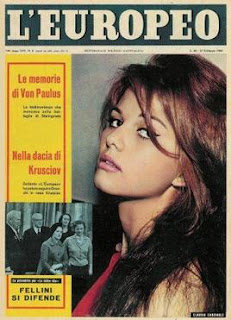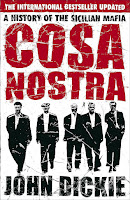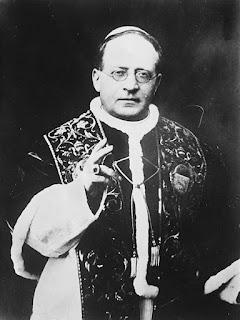NEW - Gianni Mazzocchi - publisher
Business success marred by personal heartache
The publisher Gianni Mazzocchi, a magazine editor-proprietor who founded more than 15 national magazines, of which several titles, including Il Mondo, L'Europeo and Quattroruote, continued to be published long after his death, was born on this day in 1906 in Ascoli Piceno in Marche. Mazzocchi became a publisher by accident after quitting university to support his family. But through a combination of boundless energy and a chance meeting with the architect and designer Gio Ponti, he launched himself as a magazine proprietor with enormous success. His life was bookended by personal heartache. His early years were marred when illness and misfortune struck his family. Towards the end of his life he suffered the ordeal of having his eldest daughter kidnapped and was then left a widower, the stress of the episode being blamed for the sudden death of his wife. Mazzocchi, whose father was a breeder of silkworms at a time when such skills could yield a good living, seemed destined for a career in the law after winning a scholarship to study jurisprudence in Rome. But the family’s prosperity abruptly collapsed. Read more…
________________________________________
Alfonso Ferrero La Marmora - military leader
General who became prime minister of Italy
Alfonso Ferrero La Marmora, a general and statesman who became the sixth prime minister of Italy, was born on this day in 1804 in Turin. A graduate of the Turin Military Academy, La Marmora went on to play an important part in the Risorgimento, the movement to create a united Italy. One of his older brothers was Alessandro Ferrero La Marmora, who founded the Italian army’s famous Bersaglieri corps, which entered French-occupied Rome in 1870 through a breach in the wall at Porta Pia and completed the unification of Italy. Alfonso La Marmora went into the army in 1823 and first distinguished himself in the Italian wars of independence against Austria. In 1848, La Marmora rescued the Sardinian king, Charles Albert, from Milanese revolutionaries who had resented the king’s armistice with the Austrians. Afterwards he was promoted to general and briefly served as minister of war. La Marmora suppressed an insurrection at Genoa in 1849 and commanded the Sardinian forces in the Crimean War in 1855. Later, while serving as minister of war again, he reorganised the Italian army. He then served as premier of Piedmont, governor of Milan and as the king’s lieutenant in Naples. Read more…
_______________________________________
Stefano Cardu - builder and architect
Sardinian who made fortune in Siam
The builder and architect Stefano Cardu, who enjoyed a lucrative relationship with the government of Siam in the late 19th century, was born on this day in 1849 in Cagliari, Sardinia. Cardu built many important buildings in Siam - now Thailand - including a royal palace, the national military college and a luxury hotel to house foreign diplomats, as well as contributing to the country’s expanding infrastructure with roads and bridges. The company he built up provided him with considerable wealth and when he returned to Cagliari he donated his collection of Siamese art, antiquities and other items to the city. They have been preserved in a museum that can be visited today. It is not known with certainty how Cardu came to be in Siam. After he died in 1933, an obituary appeared in a newspaper in Sardinia that claimed he was shipwrecked off the coast and swam to the shore pursued by sharks, although the story has not been corroborated. The account may be true, nonetheless. Born into a family of carpenters, he acquired some knowledge of design and construction as he was growing up, although his ambition was to sail ships. Read more…
_______________________________________
Gio Ponti - architect and designer
Visionary who shaped more than 100 buildings
Giovanni ‘Gio’ Ponti, one of the most influential architects and designers of the 20th century, was born on this day in 1891 in Milan. During a career that spanned six decades, Ponti completed more than 100 architectural projects in Italy and abroad and also designed hundreds of pieces of furniture, decorative objects and household items. As an architect, he made a significant impact on the appearance of his home city. The Pirelli Tower, which for 35 years was Italy’s tallest skyscraper, is the building for which Ponti is most famous, but it is only one of 46 in Milan. He also designed the Montecatini buildings, the Torre Littoria (now known as the Torre Branca) in Parco Sempione, the San Luca Evangelista church in Via Andrea Maria Ampère, and Monument to the Fallen in Piazza Sant’Ambrogio. Ponti’s work was by no means confined to Milan, however. Elsewhere in Italy, he designed the Mathematics Institute at the University of Rome, the Carmelo Monastery in Sanremo, the Villa Donegani in Bordighera, the Gran Madre di Dio Concattedrale in Taranto and the Hotel Parco dei Principi in Sorrento. Read more…
_______________________________________
Attilio Bertolucci - poet
Pastoral scenes and family life inspired writer from Parma
Writer and poet Attilio Bertolucci was born on this day in 1911 in San Lazzaro, a hamlet in the countryside near Parma in Emilia-Romagna. Bertolucci wrote about his own family life and became renowned for the musicality of his language while describing humble places and human feelings. He became an important figure in 20th century Italian poetry and was the father of film directors Bernardo and Giuseppe Bertolucci. Attilio Bertolucci was born into a middle-class, agricultural family. He began writing poems at the age of seven and published his first collection of poems, Sirio, when he was 18. He went to study law at the University of Parma when he was 19, but soon gave it up in favour of literary studies. He also went to the University of Bologna to study art history. He went on to teach art history at the Maria Luigia boarding school in Parma. He became a book reviewer and theatre and film critic for the Parma newspaper, La Gazzetta, and developed anti-fascist feelings along with other intellectuals at the time. He worked as foreign editor for the poetry publisher, Guanda, and introduced a range of modern poetry from overseas to Italy. Read more…
______________________________________
Eleonora Gonzaga – Holy Roman Empress
Pious princess who promoted the arts and education
Eleonora Gonzaga, Princess of Mantua, Nevers and Rethel, was born on this day in 1630 in Mantua. She grew up to marry the Holy Roman Emperor, Ferdinand III, and established a reputation as one of the most educated and virtuous women of her time. Eleonora became fascinated by religious poetry, founded a literary academy and was a patron of musical theatre. As Holy Roman Empress she developed the cultural and spiritual life at the Imperial Court in Vienna, continuing the work of her great aunt, also called Eleonora, who had introduced opera to Vienna in the early part of the 17th century. Vienna subsequently became recognised as the music capital of Europe. Eleonora was the second child of Charles Gonzaga, Duke of Nevers, who was heir to the Duchy of Mantua, and Maria Gonzaga, who was heiress to the Duchy of Montferrat. She was given a good education, became fluent in French, Spanish and Italian and learnt about literature, music and art. Having become interested in poetry, she composed religious and philosophical poems herself. A marriage was arranged for her with the Holy Roman Emperor, who imposed the condition that the Duchy of Mantua had to remain loyal to the Empire. Read more…
_______________________________________
St Peter’s Basilica consecrated
Artists helped design magnificent church
The stunning Renaissance Basilica of St Peter in Rome was completed and consecrated on this day in 1626. Believed to be the largest church in the world, Basilica Papale di San Pietro in Vaticano was built to replace the original fourth century Basilica that had been constructed on what was believed to be the burial site of St Peter. Bramante, Michelangelo and Bernini were among the many artistic geniuses who contributed to the design of the church, which is considered to be a masterpiece of Renaissance architecture. Located within Vatican City, the Basilica is approached along Via della Conciliazione and through the vast space of St Peter’s Square. The magnificent central dome of the Basilica dominates the skyline of Rome and the balcony above the entrance, where the Pope makes appearances, is instantly recognisable because of the many times it has been shown on television. It is believed that St Peter, one of the disciples of Jesus, was executed in Rome on 13 October, 64 AD during the reign of the Emperor Nero. He was buried close to the place of his martyrdom. The old St Peter’s Basilica was constructed over the burial site 300 years later. Read more…
______________________________________
Book of the Day: Censorship and Literature in Fascist Italy, by Guido Bonsaver
The history of totalitarian states bears witness to the fact that literature and print media can be manipulated and made into vehicles of mass deception. Censorship and Literature in Fascist Italy is the first comprehensive account of how the Fascists attempted to control Italy's literary production. Guido Bonsaver looks at how the country's major publishing houses and individual authors responded to the new cultural directives imposed by the Fascists. Throughout his study, Bonsaver uses rare and previously unexamined materials to shed light on important episodes in Italy's literary history, such as relationships between the regime and particular publishers, as well as individual cases involving renowned writers such as Moravia, Da Verona, and Vittorini. Censorship and Literature in Fascist Italy charts the development of Fascist censorship laws and practices, including the creation of the Ministry of Popular Culture and the anti-Semitic crack-down of the late 1930s. Examining the breadth and scope of censorship in Fascist Italy, from Mussolini's role as 'prime censor' to the specific experiences of female writers, this is a fascinating look at the vulnerability of culture under a dictatorship.Guido Bonsaver is University Lecturer in Italian and Fellow of Pembroke College, Oxford, also a tutor at Merton, Queen's, and Wadham College. As well as working on censorship during the Fascist regime, he has studied immigration in contemporary Italian cinem and is currently working on the influence of US culture in Post-Unification Italy.


.jpg)

.jpg)
.jpg)







.jpg)




.jpg)



.jpg)



.jpg)







.jpg)

.jpg)



.jpg)
